There are lots of tourist tours that let you touch the leaves at various stages of the process. But working 2-3 weeks shows a lot of commitment and perseverance. And you'll need a lot of that! Because the work of a tea maker is hard, very hard. And it takes a lot of skills that you can not pick up within weeks.
When you make tea, the leaves are like your baby. They are your priority. If they are only ready to be heated at 2 AM, that's when you have to process them! And as soon as one batch is done, the next leaves are coming already and the work starts again without much time to catch a break.
This job is so hard that you mostly see young guys performing it in the mountains. Most of them chew betel nuts, smoke cigarettes and drink very strong tea to stay awake. During the production season, they have to adapt to the leaves and can't have a regular day of work anymore.
Tea farmers in Taiwan's high mountain need to continue to adapt to hostile conditions. This year, water sprinklers proved very valuable during the draught. Otherwise, this is what you get if you can't reach the tree with sufficient water:
The pictures of tea mountains are beautiful, but this beauty requires a lot of work and fewer and fewer young people are ready to work physically in the mountains. It starts with the pickers who harvest the leaves by hand.
 |
| Changshu Hu, Alishan area |
 |
| Outdoor withering, under the sun and in the shade |
Traditionally, indoors withering is made on these round bamboo trays. While the leaves loose their moisture, the farmer and his team of workers will shuffle the leaves around several times, at regular intervals. The leaves are slightly bruised by this action and oxidize a little bit as a result.
But when you harvest several hundred pounds of leaves a day, that's a lot of work to shuffle all the leaves on these racks so often. Since there's a manpower shortage and since most high mountain Oolongs are made 'nuclear green' (with very low oxidation), this innovation is more like a natural development: the big indoor rack in an air conditioned (AC) room. (See picture below).
Most plantations have these big racks now. It's much easier to control the indoor withering of the leaves this way. The leaves are not shuffled anymore. And since the temperature can be kept constant with AC, this means that the quality of the leaves is more stable. Even the plantation on Fushou Shan has these! It makes sense if the leaves that have been harvested are of high quality and come already relatively dry (like this year). Such leaves are like a great piece of meat or fish: it's so good that it doesn't require much transformation.
We start to have problems with this method if the weather is more rainy or if we expect high mountain Oolongs that are a little bit more oxidized. Some oxidation is what adds sweetness and a nice aftertaste. It's also more gentle on the stomach.
One of my tea farmers in Changshu Hu uses both methods. He acknowledges the advantage of the big mats for the first batch of leaves that arrive quite dry. But he'll use the round bamboo racks for leaves that have more moisture, so that he can better control the withering process and add more taste (oxidation) through the gentle shuffling of the leaves!
Conclusion:
The big indoor withering rack system is a popular innovation that is now even spreading to the Wenshan (Bazhong) area! It allows for very lightly oxidized Oolong to be made in a more consistent manner and at a lower cost, by young guys with less experience and skills than older farmers.
However, there are also certain flavors that won't appear with this method. The characteristic of Oolong is to be be partially oxidized, not just very lightly oxidized. The first skill of an Oolong maker is to find the right oxidation level that brings out the flavors and preserves the spring freshness of the leaves. Such leaves are then also more suitable for roasting and long storage.
The paradox is that you this cost effective method makes most sense with expensive leaves from the highest elevations! And while I tend to prefer more traditionally made high mountain Oolongs, I don't think this is necessarily a bad innovation. It's a tool that is very suitable for certain conditions. Anyway, it's up to us to find the teas that suit us the most.

















2 comments:
Nice post! I remember visiting a factory in Lugu that used both withering methods. They actually did "toss" the leaves on the air-conditioned trays as well, by crouching beneath them and tapping the fabric of the tray so the leaves bounced around. I'm sure the effect causes less bruising than the tray method, but it was interesting to see them side by side.
Thanks for your comment and letting us know that even in low elevations, this new method is also used, even though the leaves there would require a higher degree of oxidation. That's why they tap these trays from below to mimic what they used to do with the round bamboo trays.
This simpler process helps cutting manpower costs and explains why most mass produced Oolongs can be much cheaper than traditionally made Oolongs.
Post a Comment